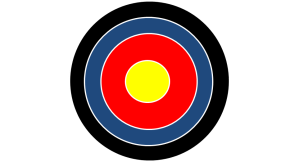The Bull’s Eye Chart is a visual representation of your goals and progress to date. Depending on your team the complexity of the chart can vary, but ideally it should be fairly simple to chart and interpret. As with all things in 6Sigma, the key to its success is understanding what it is telling you and ensuring that even a novice can reach the desired conclusion.
What does it look like?
This is a crude model to be sure, but I think that it will at least illustrate what you can expect to see when looking at a Bull’s Eye Chart.
What does it mean?
In a Bull’s Eye Chart your percentages can differ according to personal preferences, but I like the numbers that generally go along with a traditional dart board. For business purposes, say you are running a project and you decide to use this method to chart your progress. To chart your progress, use the rings like this:
- Outside of Black Ring: Any tasks that fall outside of the black ring are 0-21% completed.
- Black Ring: Any tasks that fall inside the black ring are 22-41% completed.
- Blue Ring: Any tasks that fall inside the blue ring are 42-62% completed.
- Red Ring: Any tasks that fall inside the red ring are 62-83% completed.
- Yellow Ring: Any tasks that fall inside the yellow ring are 84-100%
Ideally the yellow ring is the sweet spot because everything inside the yellow ring is on target. You will be able to view your spiral line once you plot your tasks. Anything outside of the spiral is a warning that it is behind target. Inside the schedule means that those tasks are ahead of/on schedule.
When Should I use it?
You should use the Bull’s Eye Chart when you have variables with quality and continuous metrics. A good example of this is when you can consistently measure a delivery process from cradle to grave. You should not use this method if you are unaware of the entire process or are unable to get accurate metrics. Another important thing to remember about this method is that it is not a control chart. It cannot establish process control or measure process capability.
As with all of my blogs, this is by no means a step by step tutorial in Bull’s Eye Charting but it does give you a foundation to start using them.


